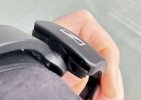-
Welcome to ASR. There are many reviews of audio hardware and expert members to help answer your questions. Click here to have your audio equipment measured for free!
You are using an out of date browser. It may not display this or other websites correctly.
You should upgrade or use an alternative browser.
You should upgrade or use an alternative browser.
New Sennheiser HD490 Pro
- Thread starter SlothRock
- Start date
solderdude
Grand Contributor
No shouty mids with producer pads.
Different kind of 'forward' sound than HD600.
HD490PRO has more comfort, better bass extension. Is more dynamic (mixer) and warmer (a bit bloaty) with producer pads.
Whether or not one finds it an upgrade or too expensive compared to any other headphone is mostly a matter of personal taste.
As there are 2 HD560S versions and 2 HD490Pro see the 4 possible comparisons below:
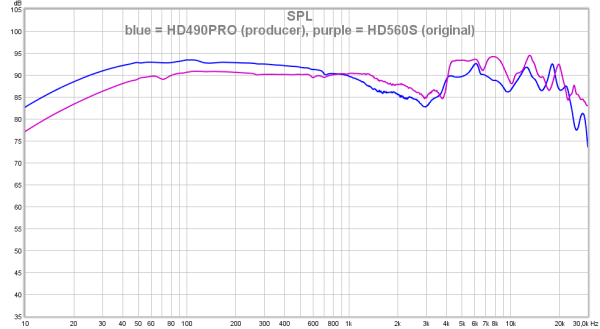
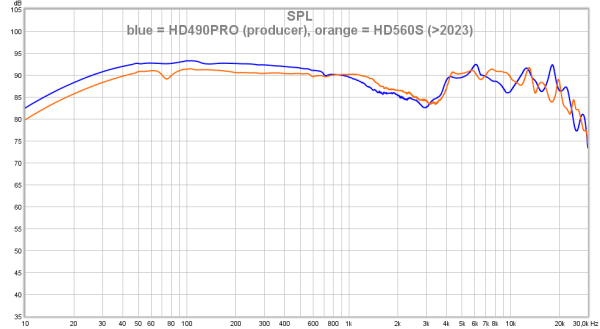
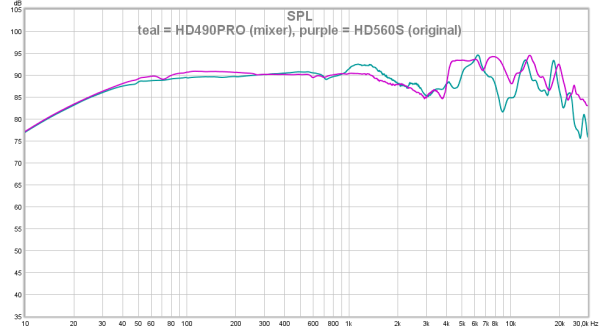
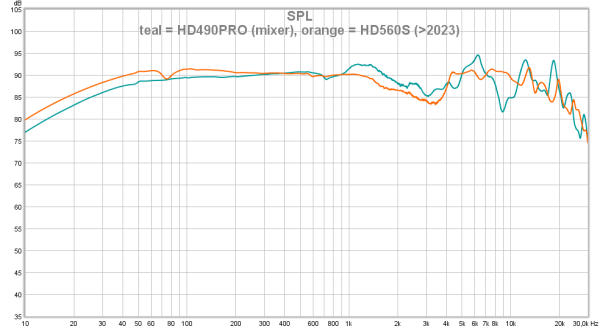
1 or 2 dB difference, in a wide band is already quite audible.
Different kind of 'forward' sound than HD600.
HD490PRO has more comfort, better bass extension. Is more dynamic (mixer) and warmer (a bit bloaty) with producer pads.
Whether or not one finds it an upgrade or too expensive compared to any other headphone is mostly a matter of personal taste.
As there are 2 HD560S versions and 2 HD490Pro see the 4 possible comparisons below:




1 or 2 dB difference, in a wide band is already quite audible.
Last edited:
Thanks. Form factor and construction on these ticks all the boxes for me.No shouty mids with producer pads.
Different kind of 'forward' sound than HD600.
HD490PRO has more comfort, better bass extension. Is more dynamic (mixer) and warmer (a bit bloaty) with producer pads.
Whether or not one finds it an upgrade or too expensive compared to any other headphone is mostly a matter of personal taste.
Very tempted to try a pair and see how they fair against my Neumann NHD30. The Neumanns replaced my HD600, and have proven to be as technically excellent to listen through as they are frustrating to live with.
solderdude
Grand Contributor
They have the same driver but, yet again, different front and back damping, different enclosure, different pads.
The drivers are tighter in tolerance (probably pre-selected) so there will be differences between NDH30 and HD490PRO. I suspect that with EQ to the same target they will be difficult to tell apart, aside from comfort and fit.
NDH30 is too expensive for me to buy/try.
Returned the HD490PRO so cannot compare directly anymore anyway.
The drivers are tighter in tolerance (probably pre-selected) so there will be differences between NDH30 and HD490PRO. I suspect that with EQ to the same target they will be difficult to tell apart, aside from comfort and fit.
NDH30 is too expensive for me to buy/try.
Returned the HD490PRO so cannot compare directly anymore anyway.
I suspect that with EQ to the same target they will be difficult to tell apart, aside from comfort and fit.
That’s pretty much what I am looking for!
490 vs your modified 58X? Thank youThey have the same driver but, yet again, different front and back damping, different enclosure, different pads.
The drivers are tighter in tolerance (probably pre-selected) so there will be differences between NDH30 and HD490PRO. I suspect that with EQ to the same target they will be difficult to tell apart, aside from comfort and fit.
NDH30 is too expensive for me to buy/try.
Returned the HD490PRO so cannot compare directly anymore anyway.
maybe to add to your question, I was curious, is the driver on HD58X related to the ones used on HD560S and HD490 PRO? the impedance is different so it's safe to say it's not exactly the same, but how similar/different are they?
solderdude
Grand Contributor
The driver is not related other than the chassis/magnet.
For music enjoyment the modified HD58X may be better suited. It is close to HD660S (but without the S)
For studio gear (HD 490 PRO is intended for that usage) the HD490 is better suited.
For music enjoyment the modified HD58X may be better suited. It is close to HD660S (but without the S)
For studio gear (HD 490 PRO is intended for that usage) the HD490 is better suited.
Count Arthur
Major Contributor
- Joined
- Jan 10, 2020
- Messages
- 2,953
- Likes
- 7,447
This is an interesting review. Mostly subjective, but the author is clear about it, and he also outlines how small are the differences between these headphones in the end (no bad choice).
What would make a HP “better” for binaural? Is it FR-related only? Low distortions? Something about phase or group delay? Some other characteristic not often measured?
Or, is the HD490 just happens to “enable” the best HRTF for the author, and therefore the best binaural experience?
I don't know, but I wonder if it coincides with what makes a headphone good for gaming. This reviewer is apparently well known at trying to decide on a best:This is an interesting review. Mostly subjective, but the author is clear about it, and he also outlines how small are the differences between these headphones in the end (no bad choice).
What would make a HP “better” for binaural? Is it FR-related only? Low distortions? Something about phase or group delay? Some other characteristic not often measured?
Or, is the HD490 just happens to “enable” the best HRTF for the author, and therefore the best binaural experience?
i figure since this headphone (and a few others recently, like Sony MDR-MV1) are meant for "3D sound" (Atmos?) that they should be judged accordingly. Though I don't know how a headphone can accentuate 3D sound qualities without DSP. It is always (or usually, with full size headphones) just two speakers, so I would think you are always really hearing stereo.
staticV3
Grand Contributor
- Joined
- Aug 29, 2019
- Messages
- 12,812
- Likes
- 21,437
Headphones cannot by themselves turn stereo into surround.I don't know, but I wonder if it coincides with what makes a headphone good for gaming. This reviewer is apparently well known at trying to decide on a best:
i figure since this headphone (and a few others recently, like Sony MDR-MV1) are meant for "3D sound" (Atmos?) that they should be judged accordingly. Though I don't know how a headphone can accentuate 3D sound qualities without DSP. It is always (or usually, with full size headphones) just two speakers, so I would think you are always really hearing stereo.
However, many video games nowadays use HRTF processing to bake binaural surround sound into their stereo output.
The result can be very effective (e.g. Hunt: Showdown), however, it depends on both the quality of the HRTF processing and on certain aspects of the headphone or IEM.
The review site rtings.com tries to quantify these aspects with their imaging and passive soundstage tests:

Our PRTF Scores And Tests: Headphones
Our pinna-related transfer function (PRTF) test measures the amount of interaction between the pinna and headphones.

Our Stereo Mismatch Scores and Tests: Headphones
Stereo mismatch is a crucial component of the headphones-listening experience that helps us assess the performance of drivers in relation to each other.
Apple for example, uses their vertical integration to achieve remarkable binaural surround sound.
The same Face ID sensors that unlock your iPhone are used to 3D-scan your head and ears, based on which they modify the HRTF processing.
All beyond meHeadphones cannot by themselves turn stereo into surround.
However, many video games nowadays use HRTF processing to bake binaural surround sound into their stereo output.
The result can be very effective (e.g. Hunt: Showdown), however, it depends on both the quality of the HRTF processing and on certain aspects of the headphone or IEM.
The review site rtings.com tries to quantify these aspects with their imaging and passive soundstage tests:

Our PRTF Scores And Tests: Headphones
Our pinna-related transfer function (PRTF) test measures the amount of interaction between the pinna and headphones.www.rtings.com

Our Stereo Mismatch Scores and Tests: Headphones
Stereo mismatch is a crucial component of the headphones-listening experience that helps us assess the performance of drivers in relation to each other.www.rtings.com
Apple for example, uses their vertical integration to achieve remarkable binaural surround sound.
The same Face ID sensors that unlock your iPhone are used to 3D-scan your head and ears, based on which they modify the HRTF processing.
I think most music would want to be heard from coming in front, as it's usually played that way, in front of an audience, often with a single singer in the middle. Though I've always liked the effect of headphones bringing you close to instruments and voices, like you are there on stage. Nonetheless, I wouldn't think a lot of music would want to be heard from coming below or above or behind you, unless it is some kind of environmental surround effect. I know it's been done a long time now with movies, but those remain a 2D image with surround sound, which is kind of at odds with each other, though virtual reality movies and games would match the 3D sound for 3D imagery.
The HD 490 Pro comes with the dearVR MIX-SE virtual mixing plug-in (Dear Reality), similar to the Steven Slate Audio VSX headphones which come with a suite of software that is supposed to recreate the sound of near-field monitors and other listening environments for music producers to mix like they normally would.
But if it needs software to sound more 3D then it suggests the software is doing much of the work, not the headphones (which use the same driver as the HD 560 and HD 400 Pro). And the same software could be used to make other headphones have similar effects, though perhaps not as well.
Last edited:
solderdude
Grand Contributor
But if it needs software to sound more 3D then it suggests the software is doing much of the work, not the headphones (which use the same driver as the HD 560 and HD 400 Pro). And the same software could be used to make other headphones have similar effects, though perhaps not as well.
Yep.
I agree with other things the guy in the video says (rankings and reasons).
Unfortunately, about the DT1990, his ranking could become different when he would have used EQ or a filter to remove the treble peak.
The comfort for S5X can be improved upon by bending the metal headband strategically to fit your head. While that works and makes it comfortable it may then not be for other heads. When only used for 1 person and bent for one's head the ranking becomes different. Of course this is a design thing. Another annoying thing is you can rotate the cups endlessly eventually you either have to remove the connectors, unwind the cable and plug it back in or rotate the cups back.
OLLO has steps to make in this department and create a better headband and lower cable microphony.
I ended up keeping the S5X (but modified one to change the properties the guy complained about) over the HD490PRO despite the excellent and better comfort of it.
That last bit is an important factor for some (me in any case).
The producer pads were just a bit too warm and fuzzy in the bass. The mixer pads had great bass but too forward/bright. The HD560S(400Pro) is right in the middle which is 'better' for enjoying music in a 'natural' tonality. This is not the design goal / purpose of the HD490PRO. It is a tool that can be used in 2 different production stages.
Still curious about NDH30, which also uses the same driver but selected on very tight tolerances and has different damping scheme. The HD490PRO also has a different damping scheme, positioning, pads, driver-ear distance and angle and this all differs from NDH30 as well.
Horses for coarses.
Last edited:
I like the HD560S very much (still playing with EQ to fine tune it). I also have the HD650 (great “as-is”), 600, and 800S.Yep.
I agree with other things the guy in the video says (rankings and reasons).
Unfortunately, about the DT1990, his ranking could become different when he would have used EQ or a filter to remove the treble peak.
The comfort for S5X can be improved upon by bending the metal headband strategically to fit your head. While that works and makes it comfortable it may then not be for other heads. When only used for 1 person and bent for one's head the ranking becomes different. Of course this is a design thing. Another annoying thing is you can rotate the cups endlessly eventually you either have to remove the connectors, unwind the cable and plug it back in or rotate the cups back.
OLLO has steps to make in this department and create a better headband and lower cable microphony.
I ended up keeping the S5X (but modified one to change the properties the guy complained about) over the HD490PRO despite the excellent and better comfort of it.
That last bit is an important factor for some (me in any case).
The producer pads were just a bit too warm and fuzzy in the bass. The mixer pads had great bass but too forward/bright. The HD560S(400Pro) is right in the middle which is 'better' for enjoying music in a 'natural' tonality. This is not the design goal / purpose of the HD490PRO. It is a tool that can be used in 2 different production stages.
Still curious about NDH30, which also uses the same driver but selected on very tight tolerances and has different damping scheme. The HD490PRO also has a different damping scheme, positioning, pads, driver-ear distance and angle and this all differs from NDH30 as well.
Horses for coarses.
I was tempted to purchase a HD490 Pro (when budget permits
 ) to better understand what it is about having a great mixing headphones or, as in the above review, a great binaural tool.
) to better understand what it is about having a great mixing headphones or, as in the above review, a great binaural tool.But your comment that the HD560S is “right in the middle” (of the HD490 Pro with either pad) threw me off: is there anything about the HD490 Pro that I couldn’t get with an EQ’ed HD560S?
Or, put another way, the HD490 Pro is a, higher quality, finely-tune HD560S (or other HD5xx), so that one doesn’t need to mess around with EQ to get that great (~”neutral”) mixing tool.
solderdude
Grand Contributor
It depends on whether or not comfort is important to you.
It also depends on whether or not you plan to EQ or you want to use as is.
The HD490 isn't a great binaural tool. The binaural tool is the software you can download for it. The headphone itself does not bring anything extra in this.
The pads emphasize different parts of the frequency range and is what sets it apart from the HD560S which only comes in one flavor.
That is unless you have an older and newer version then you have 2 slightly different flavors.
The HD560S is a headphone designed for music enjoyment. The HD490PRO is a tool for producers/mixers.
The 'producers' pads is a bit baffling to me though.
I'll try to explain... when you mix with a headphone that is a bit shy on the bass and is a little too forward and bright and the mixing engineer has a good ear he will 'turn the knobs' so that in order for the music to sound good to him he will dial in some lower bass, reduce the forwardness a little and ease up on the treble.
A bright, lean headphone thus results in fuller, bassier and 'relaxed' recording with gentle highs. Right what the doctor ordered.
When you listen to that with a 'neutral' headphone like the HD560S then you will hear the full sound with good bass and gentle treble.
When you listen to the mix (done with mixer pads) on the HD490PRO with producer pads the producer will hear an overly warm and somewhat woolly lows and a bit reduced clarity. No idea what that is good for but most young folks prefer more warmth and recordings that are a bit bright do not sound that way.
The producer must either listen at lower levels than the mixer or just prefers a warmer sound.
In any case... the producer pads sound a bit too warm/mushy to me. I like the mixer pads the most (probably because I listen to headphones and nearfields mostly) but they are a bit 'unnatural' for music enjoyment. These are tools for the producing side for which they work well.
People expect that because pros use them they must be good for music enjoyment as well. Not necessarily so alas.
Comfort there is no contest. HD490PRO >> HD650 (with lowered clamping force) > HD560S which is lightweight but 'feels' a bit cheap in comparison.
For music enjoyment, in the Sennheiser stable, the HD560S is a cheap option, the HD660S2 is a more luxurious option. The HD600/650 are classics, different bass and treble 'texture'.
It also depends on whether or not you plan to EQ or you want to use as is.
The HD490 isn't a great binaural tool. The binaural tool is the software you can download for it. The headphone itself does not bring anything extra in this.
The pads emphasize different parts of the frequency range and is what sets it apart from the HD560S which only comes in one flavor.
That is unless you have an older and newer version then you have 2 slightly different flavors.
The HD560S is a headphone designed for music enjoyment. The HD490PRO is a tool for producers/mixers.
The 'producers' pads is a bit baffling to me though.
I'll try to explain... when you mix with a headphone that is a bit shy on the bass and is a little too forward and bright and the mixing engineer has a good ear he will 'turn the knobs' so that in order for the music to sound good to him he will dial in some lower bass, reduce the forwardness a little and ease up on the treble.
A bright, lean headphone thus results in fuller, bassier and 'relaxed' recording with gentle highs. Right what the doctor ordered.
When you listen to that with a 'neutral' headphone like the HD560S then you will hear the full sound with good bass and gentle treble.
When you listen to the mix (done with mixer pads) on the HD490PRO with producer pads the producer will hear an overly warm and somewhat woolly lows and a bit reduced clarity. No idea what that is good for but most young folks prefer more warmth and recordings that are a bit bright do not sound that way.
The producer must either listen at lower levels than the mixer or just prefers a warmer sound.
In any case... the producer pads sound a bit too warm/mushy to me. I like the mixer pads the most (probably because I listen to headphones and nearfields mostly) but they are a bit 'unnatural' for music enjoyment. These are tools for the producing side for which they work well.
People expect that because pros use them they must be good for music enjoyment as well. Not necessarily so alas.
Comfort there is no contest. HD490PRO >> HD650 (with lowered clamping force) > HD560S which is lightweight but 'feels' a bit cheap in comparison.
For music enjoyment, in the Sennheiser stable, the HD560S is a cheap option, the HD660S2 is a more luxurious option. The HD600/650 are classics, different bass and treble 'texture'.
Similar threads
- Replies
- 8
- Views
- 419
- Replies
- 9
- Views
- 3K
- Replies
- 1
- Views
- 812

